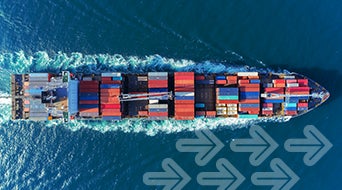How to 'Sea' the Bright Side of Freight Port Congestion
Whether it's referring to traffic, your sinuses, or shipping, "congestion" is not something most of us like to deal with very often. Unfortunately, that's exactly what's happening right now at major seaports across the country and the world. Due to the importance of these ports for global freight shipping, this congestion is having a delaying domino effect along the entire freight chain, impacting the industry at many levels.
Exactly why is port congestion (and its accompanying shipping delays) so bad right now? How can your business shipping survive and thrive during these capacity-crunched times while also maintaining or nurturing a good carrier relationship? Read on for the answers.
Port congestion bottlenecks are building up
Did you know that around 80 percent of global goods are now transported by sea? This far-reaching freight flotilla means that maintaining a constantly and consistently smooth flow of shipments through ports is more crucial than ever. Also keep in mind that while the volume of ocean shipping is increasing, the number of seaports isn't. Any disruption at the ports or sea freight delays can have a catastrophic effect and produce bottlenecks at ports, which is exactly what we're seeing now.
Causes of current port congestion include:
- The container ship-caused blockage of the Suez Canal in late March. Around $10 billion in cargo — about 12 percent of global trade — flows through this crucial waterway every single day. Even though the blockage lasted less than a week and occurred several months ago, it had a delaying ripple effect through the ocean freight industry that is still being felt at ports today.
- The ever-expanding volume of e-commerce shipments. As consumers have (likely permanently) shifted their shopping patterns toward e-commerce shipping over the last year, international shipping volume has increased dramatically. This has led to increased port congestion and shipping delays.
- Abandoned shipments at docks. The ongoing pandemic and the rise of e-commerce have also caused many businesses to close their brick-and-mortar locations. This has led to many shipments being abandoned at docks, which leaves exporters with fewer shipping containers to use.
Ocean freight shipping strategies are shifting
Unfortunately for small and mid-sized businesses (SMBs), more and more trucks are needed to transport goods away from delayed vessels at congested ports. Consequently, freight carriers are overburdened and are having to turn away many SMB shippers. As with most crises, however, there are opportunities for smart businesses to adapt to the current port congestion and keep their shipments flowing.
Here are a few recommendations to cope with the current capacity crisis:
- Reevaluate your "just in time" inventory strategy. Many SMBs have tried to streamline their strategies over the last year to keep their costs and inventory levels as lean as possible. Shifting from a "just in time" to a "just in case" strategy, even with the accompanying rise in cost and storage space, could provide an inventory buffer to help see you through supply issues caused by sea freight delays. Otherwise, you run the risk of going out of stock on critical items and seeing your online customers digitally defecting to your competitors.
- Put your freight shipping up in the air. If ocean freight delays continue to be a concern, consider shifting some of your urgent inventory needs to air freight. While not usually as economically viable as sea freight, shipping crucial shipments by air could mean the difference between a lost customer and a saved one.
Get a helping hand for ocean freight shipping
The middle of a freight capacity crunch exacerbated by port congestion is no time to try to go it alone when it comes to your freight shipping. As you look to implement the above strategies and otherwise adapt to the current shipping climate, it makes a lot of sense to partner with a third-party logistics provider (3PL) like Worldwide Express.
Our network of carefully vetted carrier partners helps thousands of SMBs find carriers to move their freight shipments every day, at rates they would never be able to obtain on their own. Combine that with our unrivaled logistics expertise and personalized service, and you've got the perfect formula for lower stress, lower rates, and higher satisfaction from your customers. Talk to the pros at Worldwide Express to learn how you can "sea" the bright side of ongoing freight port congestion.
